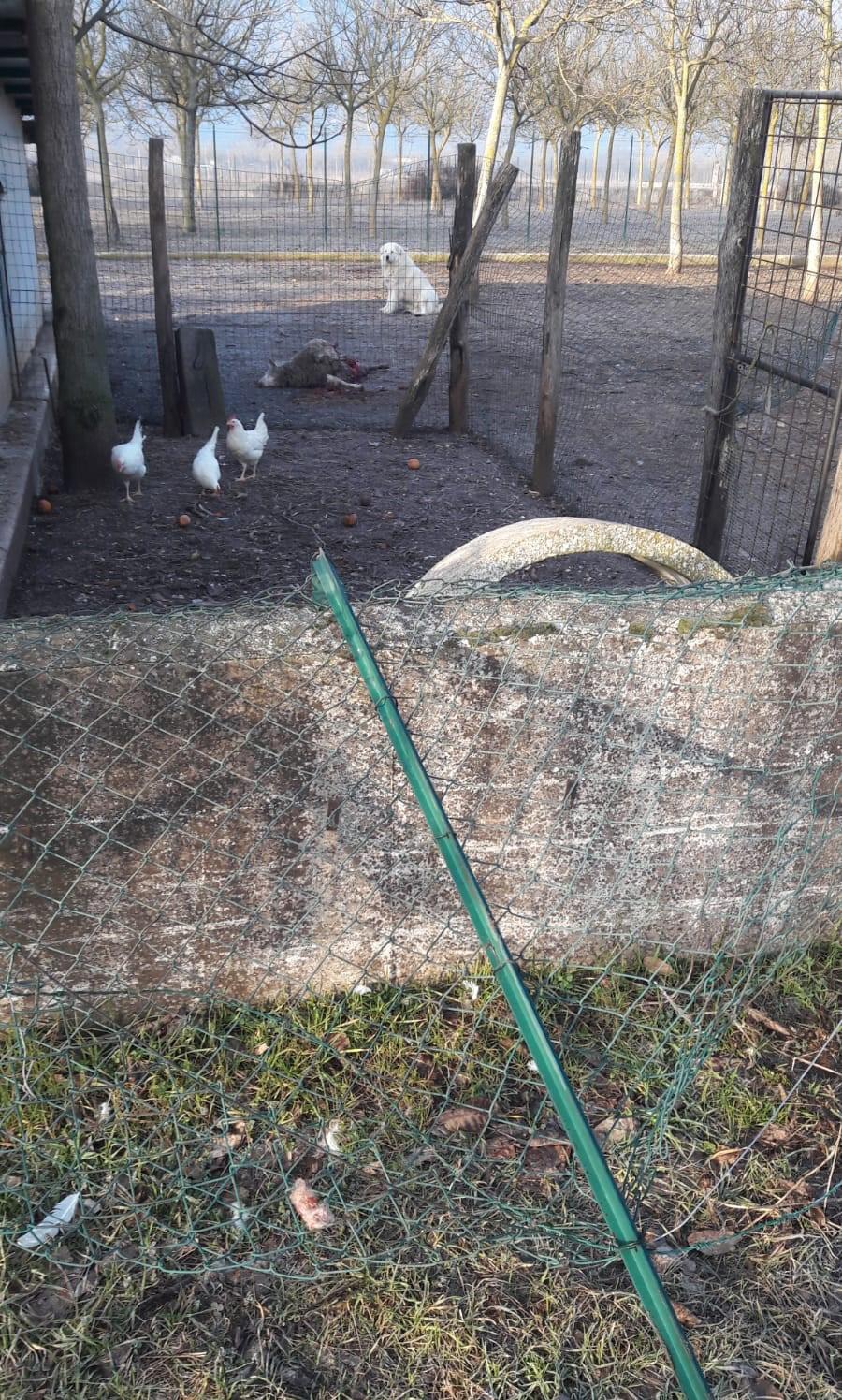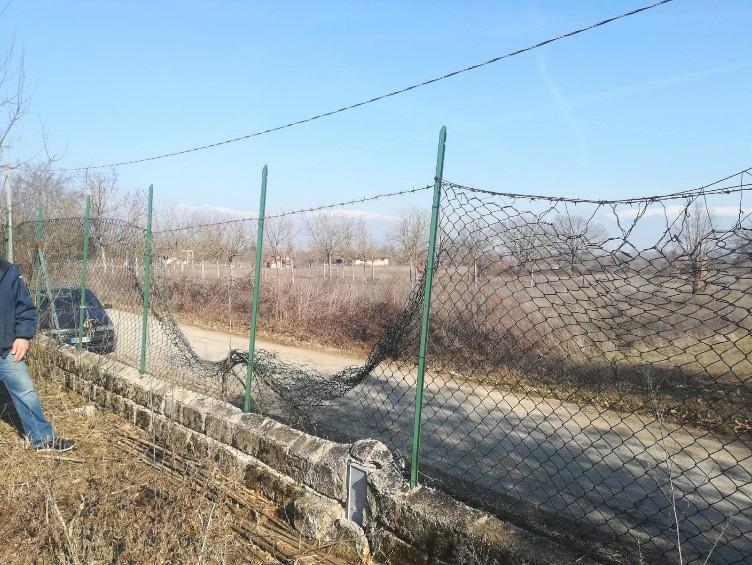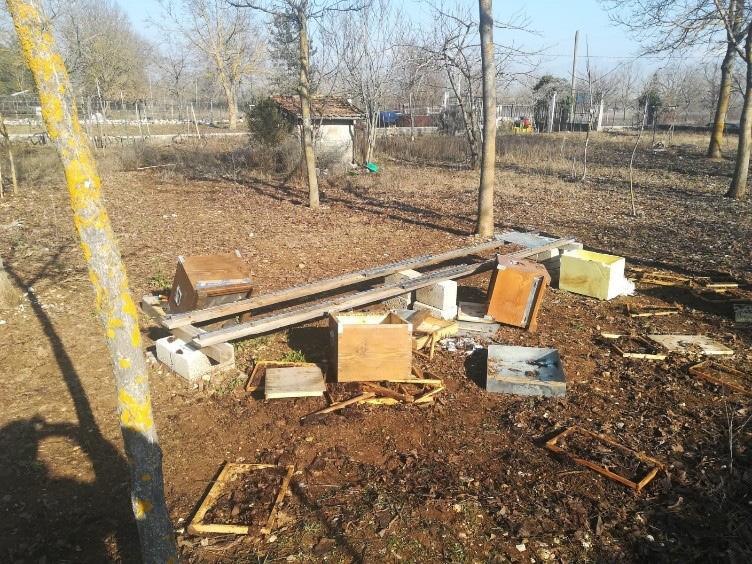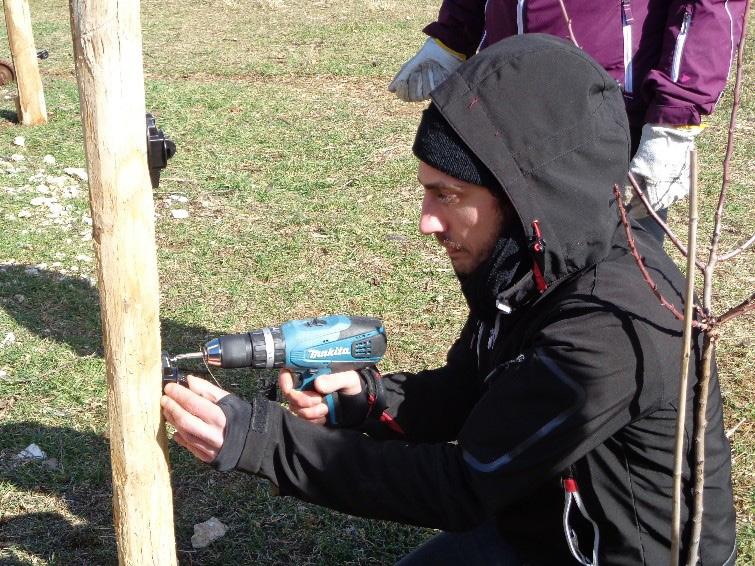
17 minute read
Demolition bear / Demolition bear
a cura di Mario Cipollone
written by Mario Cipollone
Advertisement
Era il periodo di Natale del 2018 quando ricevemmo diverse telefonate da persone di Ortucchio, Luco dei Marsi e Trasacco che avevano subìto danni da orso ai loro allevamenti domestici e chiedevano un recinto elettrificato per tutelare i propri beni. Eravamo stremati da un anno molto faticoso in cui avevamo lavorato strenuamente per la convivenza, installando una trentina di misure di prevenzione, e pregustavamo il nostro “letargo” per ricaricarci in vista degli impegni del 2019, ed ecco che un orso aveva deciso di non andare in ibernazione, complici le temperature miti, lo scarso innevamento e la dispensa annuale fornita dalle tante attività agricole e zootecniche dei paesi della Marsica Fucense.
Le richieste provenivano da piccoli allevatori di aree fuori parco dove alcuni interventi erano stati già effettuati l’anno prima in virtù della nostra collaborazione con Rewilding Europe e AISPA e per l’attuazione delle azioni previste dalla Legge n. 15 per conto della Regione Abruzzo. Conoscevamo bene la realtà In the Christmas time of 2018, we received numerous calls from the people of Ortucchio, Luco dei Marsi and Trasacco. These people had suffered bear damage to their domestic breeding farms and were asking for electric fencing to protect their assets. We were exhausted from a very tiring year working strenuously for positive coexistence and installing about thirty preventive measures, so we were looking forward to our "dormancy" to recharge in view of the commitments of 2019. However, here a bear decided not to go into hibernation, thanks to the mild temperatures, the scarce snow cover and the year-round food provisions from the many agricultural activities in the towns of Marsica.
The requests came from small breeders in areas outside the park where some interventions were carried out the year before, by virtue of our collaboration with Rewilding Europe and AISPA and for the implementation of the actions provided by the Law N. 15 of Abruzzo Region. We know that these Muni
di quei Comuni, ponti naturali verso la Valle Roveto e, quindi, gli Ernici-Simbruini, area di espansione naturale per la popolazione di orso marsicano verso ovest, ritenuta idonea a ospitare un nucleo di almeno 14 femmine riproduttive, quindi la “terra promessa” per la conservazione di questa entità faunistica unica dell’Appennino Centrale.
Non potevamo correre il rischio che i conflitti con le attività rurali sfociassero nel gesto estremo di eliminare l’orso, com’era avvenuto più di recente a Pettorano sul Gizio nel 2014. Le risorse economiche dell’associazione erano ridotte al minimo e anche quelle fisiche. Intervenire o non intervenire? Chi avrebbe voluto quell’orso sulla coscienza se fosse avvenuto il peggio? Da associazione del fare, si decise di rispondere alle richieste delle comunità di Ortucchio, Luco dei Marsi e Trasacco e impedire che l’intensificarsi dei danni esasperasse i conflitti. Ricevuto un cospicuo ordine di recinzioni elettrificate e contattato un fabbro locale per realizzare porte a prova d’orso, ci mettemmo all’opera, con forze volontarie minime, visto il periodo invernale, per cercare di arginare l’esuberanza dell’amico orso che si traduceva in un crescente numero di danneggiati e di telefonate al nostro “centralino”, favorite anche dalla prassi di certi enti di delegare a Salviamo l’Orso la soluzione dello spinoso “problema”.
Recinzioni metalliche abbattute, muretti a blocchetti di cemento dissestati dal peso dell’animale che, nell’atto di scavalcarcipalities are in an area that acts as a natural bridge towards the Roveto Valley and therefore the Ernici-Simbruini mountains; an area of natural expansion for the Marsican bear population, which is considered suitable for hosting at least 14 reproductive females, and is therefore the "promised land" for the conservation of this unique wildlife species of the Central Apennines. We could not run the risk that the conflicts with rural communities resulted in the extreme act of killing the bear, which happened more recently in Pettorano sul Gizio in 2014. Both economic and physical resources of the association were reduced to a minimum. To intervene or not? Who would have wanted that bear on one’s conscience if the worst had happened? It was decided we must respond to the requests of the communities from Ortucchio, Luco dei Marsi and Trasacco to prevent possible intensification of the damage and, therefore, the exacerbation of conflicts. We collected a large number of electric fences and contacted a local blacksmith to prepare bear-proof doors. So, we set to work, with minimal voluntary forces, given the winter period, to try and stem the enthusiasm of our friend the bear, who had been responsible for an increasing number of damaged farms and consequent phone calls to our “switchboard”. This was also favoured by the practice of certain institutions also seemed to prefer to delegate finding the solution of the thorny “problem” to Salviamo l’Orso.
Metal fences were pulled down, concrete block walls crushed by the weight of the
li, si trascinava dietro i pali e la rete che sostenevano, pecore uccise nonostante la guardiania di un paio di pastori abruzzesi: avevamo a che fare con un maschio adulto di orso marsicano molto determinato a raggiungere il proprio obiettivo, ovvero alimentarsi a spese degli allevatori che avevano invaso l’antico territorio della sua specie con stalle, pollai e apiari non protetti a sufficienza. C’erano pochi dubbi sull’identità dell’esemplare per “coazione a ripetere”, ovvero “condizioPh: Archivio SLO namento alimentare”, entità dei danni e dimensioni. Si trattava di M19, al secolo l’orso Mario.
Mi ero misurato con Peppina (F1.99) per il progetto Comunità a Misura d’Orso del Genzana e con Gemma (FP01) nell’ambito della convenzione con il Par
co Nazionale d’Abruzzo, Lazio e Moli
se, ma la forza di Mario mi aveva sempre impressionato, come la sua capacità di varcare ogni ostacolo piegandolo o abbattendolo al suo passaggio. Mario corrispondeva alla mia visione archetipica dell’orso grande, possente e cacciatore. A mio avviso, ammiriamo l’orso per i caratteri che lo rendono più temibile. Per dirla con le parole di George Monbiot, abbiamo bisogno dell’orso per animal who, in the act of climbing over them, dragged behind the poles and the fence they supported, sheep killed despite the guard of a couple of Abruzzese mastiffs; we had to deal with an adult male Marsican bear very determined to achieve his goal to feed himself. This determination came at the expense of breeders who had invaded the ancient territory of his species and not sufficiently protected their stables, chicken coops and apiaries. There were very few doubts about the identity of the individual due to “compulsion to repeat”, or “food conditioning” and due to the size and the extent of damage. It was M19, Mario the Bear.

I had contended with Peppina (F1.99) for the Bear Smart Community Genzana project and with Gemma (FP01) as part of the agreement with the Abruzzo, Lazio and Molise National Park, but Mario’s strength had always impressed me, as well as his ability to bend or bring down every obstacle in his way. Mario was my archetypal vision of a big, powerful and carnivorous bear. In my opinion, we should admire the bear for the characteristics that make it more fearful. To put it in the words of George Mon
uscire dalla “noia ecologica” della nostra società iper-tecnologica. Con gli orsi cosiddetti “problematici”, soprattutto con Mario, non c’era il rischio di annoiarsi. Mi piace pensare che ci fosse un tremito di ammirazione e rispetto anche nella voce di chi si lamentava delle sue incursioni.
L’orso Mario era divenuto, suo malgrado, l’ambasciatore del mondo selvatico in una società agricola intensiva e industrializzata come quella del Fucino, in periferie che, tra discariche abusive, carotai diffusi, randagismo canino ed espansione edilizia rappresentano di per sé una minaccia al paesaggio naturale. Le persone avrebbero ceduto al fascino del selvatico, di avere un grande predatore che si aggirava prevalentemente di notte tra le loro case, riappropriandosi degli spazi fisici e temporali a cui le attività umane lo avevano relegato, oppure avrebbero cercato inesorabilmente di imporre il proprio controllo su di esso? Questa era la domanda ricorrente a cui abbiamo dovuto rispondere dal 2015 e, nel caso di Mario, dall’estate 2018 alla primavera del 2019. Gli animali da cortile, altrimenti destinati al frigorifero del proprietario, e gli orsi che li minacciavano erano ostaggio di un eventuale insuccesso e di alcune variabili che sfuggivano al nostro controllo: il numero preponderante delle proprietà da mettere in sicurezza in relazione ai fondi disponibili e la tolleranza della popolazione, laddove un unico facinoroso avrebbe potuto porre fine ai nostri sforzi eliminando l’antagonista. Sulla natura degli orsi condizionati dal biot, we need the bear to escape from the “ecological boredom” in our hyper-technological society. With the so-called “problematic” bears, especially with Mario, there is no risk of getting bored. I like to think that there was a tremor of admiration and respect even in the voice of those who complained about his raids.
Mario the bear had become, unbeknown to himself, an ambassador of the wild world in areas of intensive and industrialized agricultural activity; in places such as Fucino that between illegal landfills, widespread carrot mounds to feed cattle, stray dogs and urban sprawl, are themselves a threat to the natural landscape. Would people succumb to the charm of the wild and let a large predator roam free by their homes mainly at night, or would they rather try to inexorably impose their control over it?
This is the recurring question we have had to answer from 2015 and, in Mario's case, from summer 2018 to spring 2019. The farmyard animals, otherwise doomed to the owner’s refrigerator, and the bears that threatened them were subject to variables that were beyond our control; the predominant number of properties to be made safe in relation to the available funds and the tolerance of the people, where a single troublemaker could have put an end to all our efforts and eliminate the antagonist. We had little doubt about the nature of bears being conditioned by food: as long as there were food sources available, Mario would continue to use them. And so, we
cibo avevamo pochi dubbi: finché ci fossero state fonti alimentari disponibili Mario avrebbe continuato a servirsene. E così iniziammo una nuova partita a scacchi con l’orso, un “avversario” forte e intelligente, cercando di mettere in sicurezza quelle strutture che ritenevamo di volta in volta più vulnerabili nell’impossibilità di proteggerle tutte lo stesso giorno. In alcuni casi, come il 22 febbraio, riuscimmo a impedire che l’orso danneggiasse un apiario installando una recinzione elettrificata poche ore prima che tentasse l’incursione. Una rete metallica al confine della proprietà presentava la tipica piega a U prodotta dal peso dell’orso nell’atto di scavalcarla. Era indiscutibile che fosse diretto verso le arnie e la nostra gioia più grande fu ricevere la telefonata di ringraziamento dal giovane apicoltore. In altre circostanze, invece, tra il sopralluogo e la successiva realizzazione della recinzione non riuscimmo a impedire che l’orso reiterasse il danno. A fronte di risorse umane e materiali limitate, l’animale aveva il vantaggio di poter scegliere tra diverse proprietà in cui trovare ciò di cui aveva bisogno. Se noi riuscivamo a mettere in sicurezza una determinata area, poteva sempre cambiare zona started a new chess game with the bear, a strong and intelligent “competitor”, trying to secure those structures that we thought were most vulnerable from facing the impossibility of protecting them all on the same day. In some cases, such as February 22, we managed to prevent the bear from damaging an apiary by installing an electric fence a few hours before Mario attempted the raid. A wire mesh on the edge of the property had the typical U-shaped fold produced by the weight of the bear in the act of climbing over it. It was indisputable that the bear was heading for the hives and our greatest joy was to receive the thank you call from the young beekeeper. In other circumstances, however, between the initial survey and the following construction of the fence, we were unable to prevent the bear from repeating the damage. In the face of limited human and material resources, the animal had the advantage of being able to choose between different properties to raid in which to find what it needed. If we were able to secure a certain territory, it could always change areas or even town, temporarily moving from Luco dei Marsi to Ortucchio or Trasacco, and then returning

o addirittura paese, trasferendosi temporaneamente da Luco a Ortucchio o Trasacco, per poi tornare a Luco quando intervenivamo anche in questi ultimi Comuni. La tolleranza dei malcapitati allevatori era messa a dura prova. Cominciava a circolare la storia che l’orso in questione non fosse un marsicano, ma un esemplare “sloveno” rilasciato non si sa da chi, dal PNALM probabilmente, “perché il marsicano non ha mai fatto questi danni”. La leggenda, che ci siamo trovati a dover sfatare più volte, si Ph: Archvio SLO aggiungeva naturalmente alle solite recriminazioni contro il Parco e l’invito a “riprendersi l’orso”, neanche quest’ultimo fosse un cane sfuggito alla custodia del padrone. La spersonalizzazione del nemico è la strategia che prelude alla sua distruzione. Se l’orso era “alieno” al territorio sarebbe stato più facile giustificarne l’eliminazione per ristabilire un presunto ordine naturale alterato. La storia dell’umanità ci insegna che considerare un’etnia “diversa”, pertanto inferiore o subumana, è sempre stato funzionale alla conquista e allo sterminio.
L’opera di messa in sicurezza degli alleto Luco when we also intervened in the previous Municipalities. The tolerance of the unfortunate farmers has been severely tested. A story then began to circulate about the bear not being Marsican, but a “Slovenian” specimen released deliberately, probably by the Abruzzo, Lazio and Molise National Park, “because the Marsican bears have never been so destructive”. This legend, that we had to dispel several times, was naturally added to the usual allegations against the Park and the invitation to “take back the bear” was raised by the public, like a dog who escaped the owner’s custody. Depersonalization of the enemy is the strategy that foreshadows its destruction. If the bear was “alien” to the territory it would have been easier to justify its elimination to restore an alleged altered natural order. The history of humanity teaches us that considering something “different”, therefore inferior or subhuman, has always been functional to conquest and extermination.

The work to secure farms with bear-proof fences and doors continued sustainably until June 2019, with the protection of 33
vamenti con recinti e porte a prova d’orso è continuata in maniera sostenuta fino al giugno 2019, con la protezione di 33 strutture, grazie a fondi propri e alla sinergia con il team di Rewilding Apennines. I danni erano già sensibilmente diminuiti in seguito ai nostri interventi, finché da fine giugno si azzerarono del tutto. Avremmo sperato che ciò dipendesse dalla bontà del lavoro svolto, ma probabilmente il motivo reale era la scomparsa dell’orso Mario, che da allora non è stato più segnalato. Purtroppo i supereroi sono immortali solo nella fantasia. Pur non avendo prove certe della sua morte “violenta”, il triste epilogo di quella storia appariva sempre più probabile. Alcune voci da bar vorrebbero che Mario sia stato ucciso a fucilate e mangiato in Valle Roveto. I bracconieri si saranno intossicati, dal momento che, da un’analisi del sangue in seguito a una cattura per dotarlo di radiocollare, Mario era risultato positivo a diversi pesticidi assimilati nutrendosi di ortaggi trattati. Alcuni pensano che sia stato ucciso per errore durante una battuta notturna di caccia di selezione, scambiato per un cinghiale. L’ipotesi più probabile è che sia morto avvelenato, forse ingerendo dei bocconi destinati ad alcuni cani randagi. A noi piace properties, thanks to Salviamo l’Orso’s own funds and to the synergy with the Rewilding Apennines team. The damage had already significantly decreased following our interventions, and they completely disappeared by the end of June. We would have hoped that this depended on the quality of the work we had done, but probably the real reason was the disappearance of Mario the bear, which has not been reported since then. Unfortunately, superheroes are immortal only in fantasy. Despite lack of certain evidence about his “violent” death, the sad ending of that story seemed increasingly probable. Some local voices spoke of Mario having been shot and eaten in the Roveto Valley. If true, the poachers will have become intoxicated, as results from a previous blood test following a capture to equip radio collars, Mario tested positive for several pesticides that he assimilated by feeding on treated vegetables. Some people think he was killed by mistake during night hunting, perhaps mistaken for a boar. The most probable hypothesis is that he died from poisoning, perhaps swallowing baits intended for stray dogs.

We like to think that he is still alive, perhaps in a distant forest or moun
pensare che sia ancora vivo, magari in un bosco o in una montagna lontani per effetto di quella sorta di rito di iniziazione per gli orsi, soprattutto maschi, che si chiama dispersione, oppure che sia morto per cause naturali.
Penso che senza Mario anche quei portatori di interesse, che oggi forse tirano un sospiro di sollievo perché non c’è più, si sentano più vuoti e annoiati. Sono certo che alcuni di loro sono effettivamente rattristati dalle notizie che circolano sulla sua morte. In ogni modo, la storia dell’orso Mario ci insegna che è meglio che un orso stia lontano dalle abitazioni. Non per niente in America è stato sviluppato il modello delle Bear Smart Communities proprio per impedire che i rapporti tra uomini e orsi degenerino a scapito di questi ultimi. La gestione sconsiderata di attrattori alimentari come alberi da frutto e rifiuti nei pressi delle strade è quasi certamente la causa degli investimenti mortali di due femmine il 22 agosto e il 24 dicembre 2019 rispettivamente a Rionero Sannitico e Castel di Sangro, territori a cavallo tra il PNALM e il Parco Nazionale della Majella. Come sottovalutare la piaga del bracconaggio con armi da fuoco e lacci, se qualcuno nel 2020 continua a vantarsi di aver sparato all’orso Mario e di esserselo mangiato, neanche provenisse da un Paese stremato da fame e guerra? O come possiamo dimenticare l’orso ucciso da un laccio a Picinisco (FR), i cui resti sono stati rinvenuti dal personale di sorveglianza del PNALM nel maggio 2018, anche se non abbiamo potuto stigmatizzare l’accaduto tain, due to a kind of initiation rite for bears, especially males, which is called dispersion, or that he died of natural causes.
I believe that without Mario even those stakeholders, who today perhaps breathe a sigh of relief because he disappeared, feel emptier and more bored. I'm sure some of them are actually saddened by the news about his death. Anyway, the story of Mario the bear teaches us that it is better for a bear to stay away from households. The Bear Smart Community model was developed in America precisely to prevent relationships between humans and bears deteriorating at the bear’s expenses. The reckless management of food sources such as fruit trees and waste by the roads is almost certainly the cause of two females killed by vehicles in 2019 on August 22 and December 24, in Rionero Sannitico and Castel di Sangro, territories which straddle the ALMNP and the Majella National Park.
It is dangerous to underestimate the scourge of poaching by firearms and snares. Why does someone in 2020 continues to boast of having shot Mario and eaten him, though he does not come from a country exhausted by hunger and war? We cannot forget the bear killed by a snare in Picinisco (FR), the remains of which were found by the ALMNP’s rangers in May 2018. We could not stigmatize the incident as we would have liked, first due to the secretive investigation and then because the news appeared out of date. Unfortunately, the “bad habit of killing”
come avremmo voluto, prima in ossequio al segreto investigativo e poi perché la notizia appariva superata? Il “vizio di uccidere” purtroppo non è passato di moda, come testimoniano recenti notizie di avvelenamenti e bracconaggio a danno di selvatici.
Comunque e dovunque sia finito, penserò a Mario come al messaggero di una convivenza difficile, ma non impossibile, tra noi umani e orsi. Lo ricorderò sempre come “Demolition bear”. . has not gone out of fashion, as recent reports of poisoning and poaching against wild animals testify. Anyhow and wherever he ended, I will think of Mario as the messenger of a difficult, but not impossible, coexistence between us humans and bears. I will always remember him as “Demolition bear”. .






